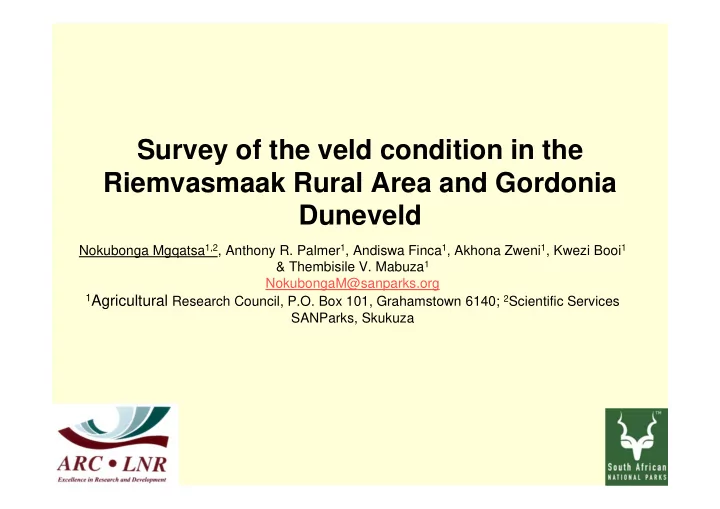

Survey of the veld condition in the Riemvasmaak Rural Area and Gordonia Duneveld Nokubonga Mgqatsa 1,2 , Anthony R. Palmer 1 , Andiswa Finca 1 , Akhona Zweni 1 , Kwezi Booi 1 & Thembisile V. Mabuza 1 NokubongaM@sanparks.org 1 Agricultural Research Council, P.O. Box 101, Grahamstown 6140; 2 Scientific Services SANParks, Skukuza
Introduction • Regular rangeland condition surveys are necessary to provide feedback to graziers and managers • GIS and remote sensing products provide the decision-making framework for optimizing the distribution of samples • Careful stratification and location of sample sites ensures that future sampling efforts will be able to detect trends in species composition and production
Aim • Determine the veld condition of the RRA and adjacent commercial farms
Study area
Methodology • Site selection: identified gradients of elevation, slope, aspect and biomass within the study area using GIS • A high resolution (30 m) digital terrain model (ASTER DEM) was used for elevation, aspect and slope. MODIS fPAR used for biomass • Sites were selected to represent examples of the full range of edaphic conditions and were located away from obvious disturbances
Methodology cont… • Surveyed 100 m line transects at each 35 sites • Summarised data by species and canopy cover for each transect • Defined 5 veld condition classes based on cover and species composition
Methodology cont… Table 1. Tables representing PTD calculations
Results & conclusions • The overall condition of the study area was poor • Good condition = 3 sites, moderate = 4 sites, poor = 18 sites & very poor = 10 sites • Low cover & low species diversity • There were no samples in the very good condition class
Results & conclusions cont…
Acknowledgements • ARC/DAFF • SANParks
Thank you!!!!
Recommend
More recommend